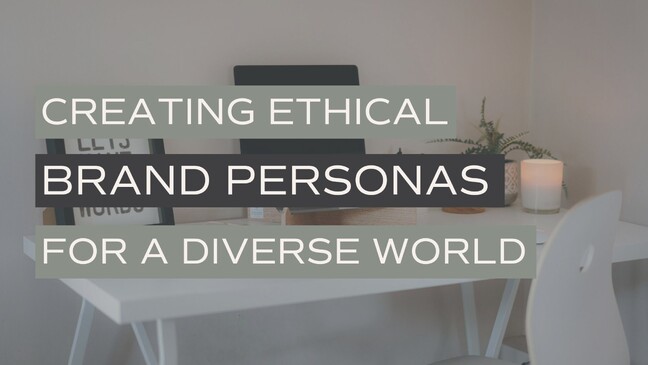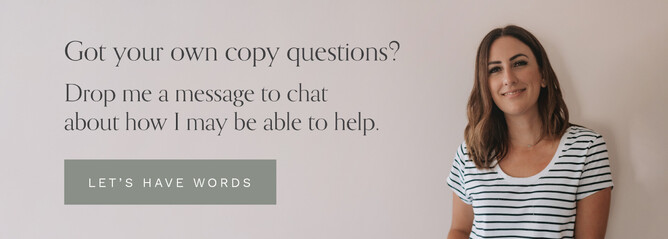Creating (ethical) brand personas
Who are you talking to? If your answer to this question is: anyone and everyone, we've got some work to do. It's a statement I hear a lot. After all, if you can help everyone, why wouldn't you?
But here's the thing: perhaps you could work with anyone, but will you always do your best work? Is there not a type of client you prefer over another?
Even if your service or product can benefit any type of human, if you drill down a little deeper into where your heart really lies, you'll realise there is in fact a very specific type of client who you really vibe with. One with projects you get excited about. One where you pick up energy that inspires you creatively. Or one that makes you feel like you are 100% in the right job.
It's important to have a clear understanding of who your target customer is, so that you can craft messages that really resonate with them. The thing is, most of the templates for creating personas are out of date and don't help you create a real representation of the diverse world we're living in.
What is a buyer persona?
A buyer persona is a fictional representation of your ideal customer(s). Personas are used to help guide and target your brand messaging, and ensure you are being very intentional about who you are trying to reach.
Personas give you a framework that helps you understand exactly how you need to craft your messages. Then, the way you communicate not only resonates with the right people, but it makes them feel like they belong - like they're in the right place, and found a brand who actually understands them.
The trouble with traditional personas
A quick search online for 'persona templates' shows that largely, we have a problem. Brands are being encouraged to create buyer personas that call out distinct buyer demographics - things like gender, occupation, age, relationship status, religion, socio-economic background, and so on.
The thing is, these demographics are largely based on assumption. And in our beautifully diverse world, those assumptions just don't really fly. What you need are personas that provide a more realistic reflection of your real-life audience. Buyer personas should, therefore, be based on commonalities, not attributes.
Before you ask: yes, some businesses will have a very niche customer. BUT a demographic stereotype doesn’t apply to all businesses, especially in a world with growing diversity.
Unless you are selling to a very select audience, where you know (ie. you have the data) the very specifics of the customer you’re targeting, then you should not make assumptions about gender, age, social status, income or any other defining features or demographics that I so often see come through in outlined personas.
Of course, I think it can be handy to understand the data around gender or age, but that doesn’t necessarily mean your marketing messages should be shaped entirely by these things.
If demographics do dictate your audience, it's still better to define your personas by the characteristics or behaviours of this demographic, rather than by, say, income, age, or perceived social status.
Keeping your customer at the centre of your messaging is critical, but this doesn’t happen by making assumptions about their age, what kind of car they drive and whether their name is Karen or Dave. It happens by knowing what matters most to them!
Here’s a story that might help:
I used to work for a tech company that served agricultural businesses (farmers). Every year we’d attend the biggest event on the farming calendar here in NZ. If ever there was a place where assumptions and stereotypes take place, it’s probably in farming, right? One year I remember chatting to a man and he told me he was 85 years old. He pulled out his smartphone and he told me how he manages his entire farming operation from the palm of his hand. As soon as the milk truck leaves the driveway he has a notification about how much milk there was and how much money he’d made and everything. This was among many other apps that he had on his phone.
If we, as a company, had made any assumption about who - in terms of age - was using the product and how they understood the value, we could have really alienated a sector of the audience. That 85 year old man had the same motivations, the same challenges and the same desired outcome as a farmer half his age.
I hope that helps you understand where I’m coming from with this. I know it can help to imagine who you are talking to, but it pains me to see brands trying to fit people in a box using stereotypes or assumptions. And a lot of the ‘template’ style personas I see, do just that.
I know there will be people who say, 'oh I only sell to pregnant mothers'. OK, in that instant, you’re probably going to have gender specific, age-range specific demographics you can refer to, but even then, you can’t make assumptions about where people who like to buy organic bamboo baby blankets live. You just can’t. Acknowledge we live in a world with huge diversity and ditch the demographic-led personas and focus on building out personas based on ideologies, values, needs instead, and you will see that your buyer personas become inclusive in the right ways, and exclusive in the right ways.
Exclude first
OK, I'm sorry. I did say that these were inclusive personas, and here I am telling you to exclude. But hear me out. Personas, by their very nature, are exclusive, and it is important to be intentional about who you don't serve. We just need to make sure they're exclusive in the right ways.
That does mean that, first, we need to see who really doesn't need to be considered as part of your audience. Doing this though, should also show you that demographics largely won't play a part in your personas from that point on.
For example, if you are only targeting people within a certain geographical area, then make a note of that. Or if you are only targeting people who are diabetic then you'll make a note of that.
Research
I did say assumptions are OUT when it comes to creating personas. Which is why your personas should always be based on research.
Let's talk briefly about homophily. Homophily refers to the tendency for people to have (non-negative) ties with people who are similar to themselves in socially significant ways. Basically, it means you're more likely to have contact with people who are like you, than not. This can mean we end up only looking at things from our own perspective (or privilege), and therefore excluding customers who may have a different background, experience or perspective from our own. This can also be considered as unconscious bias.
With research, we're better positioned to focus on similarities, rather than what makes us different. It also gives us insights we may never have thought of. Reach out to previous or current customers and ask if you can run a few questions by them. These questions are not designed to elicit feedback on your work necessarily, but are more targeted around understanding their motivations, pain points, challenges, and what the outcome has helped them achieve.
Focus on the information that you collect being actionable—something that you can use to understand the journey they need to take to get from where they are today to the point where they buy whatever you’re selling and become your customer.
Spot the trends
When you start to uncover answers to those questions, you'll soon see that your ‘ideal client’ doesn’t have to be defined by their gender or income bracket or age, but instead by commonalities such as their ideology, their values, perhaps certain personality traits, or their working or communication style.
Group your archetypes
Most brands will have anywhere from 1 client persona to 3 or 4, depending on the type of product or service they offer. You have probably noticed there are a number of distinct trends when it comes to grouping your customers from your research. Traditional persona templates will ask you to give each persona a name, age, gender, job title, marital status etc.
But my advice, unless it's a necessary part of defining a persona, we don't need to create an assumed identity. The reason I don’t recommend giving your person a name and an identity is that fake people are not real (duh). You don’t feel connected to a fake person - and when you create a fake person, it plays a part in dehumanising your audience.
If you really want to give your persona a name, then think about a past client - because when you think about this persona then you’re more likely to think of a REAL person, and therefore talk to them, as a real person. Humanising your audience is where everything starts.
But instead, we can create archetypes, drawing on the key trends we've identified. For example, you might call your personas: The Rebellious Change Seeker; The Curious Creative; The Conscious Parent... you get the idea.
The overall aim here is to synthesise the common needs, motivations and pain points of your audience, without defining them by demographics and therefore unnecessarily excluding someone you perhaps shouldn't.
In our diverse world, we can't make assumptions about what matters to our customers, just because they fall into (or outside of) a certain demographic. As brands, it is important to acknowledge we live in a world with huge diversity, to ditch the demographic-led personas and to focus on building out personas based on ideologies, values, and needs instead.
In doing this, you will see that your buyer personas become inclusive in the right ways, and exclusive in the right ways. Your value proposition becomes clearer, you'll see your messaging resonating with the right people, you'll remove bias from your content and you'll create greater connection with your audience through empathy and identification.


